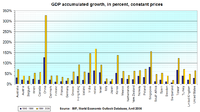
Photo from wikipedia
Technological progress leads to factor shares change by changing the marginal productivity of factors or the substitution elasticity between factors. This is a key energy issue affecting total factor energy… Click to show full abstract
Technological progress leads to factor shares change by changing the marginal productivity of factors or the substitution elasticity between factors. This is a key energy issue affecting total factor energy performance. The study used data from 1980 to 2016 of China’s non-ferrous metals industry (CNMI). In the first part, the paper employs ridge regression to study the substitution effect and technological progress difference among factor inputs. Second, the paper analyzed the impact of technical indexes on energy performance by using the Data Envelopment Approach (DEA)-Malmquist framework. The results show a higher output elasticity of labor (0.300–0.451) than that of energy (0.289–0.403) and capital (0.230–0.346). China’s non-ferrous metals industry shows labor-biased technological progress. The results indicate the existence of mutual substitution relations among the three factors. The substitution elasticity among input factors shows a convergence trend. The substitution elasticity between labor and energy (1.062–1.199) emerge as the highest. This is followed by the substitution elasticity of energy for capital. In addition, the technological progress difference between the three inputs become smaller gradually. Whether from the national average or regions, energy performance has improved significantly, which benefits from the impact of technological progress and changes technical efficiency.
Journal Title: Energy
Year Published: 2020
Link to full text (if available)
Share on Social Media: Sign Up to like & get
recommendations!